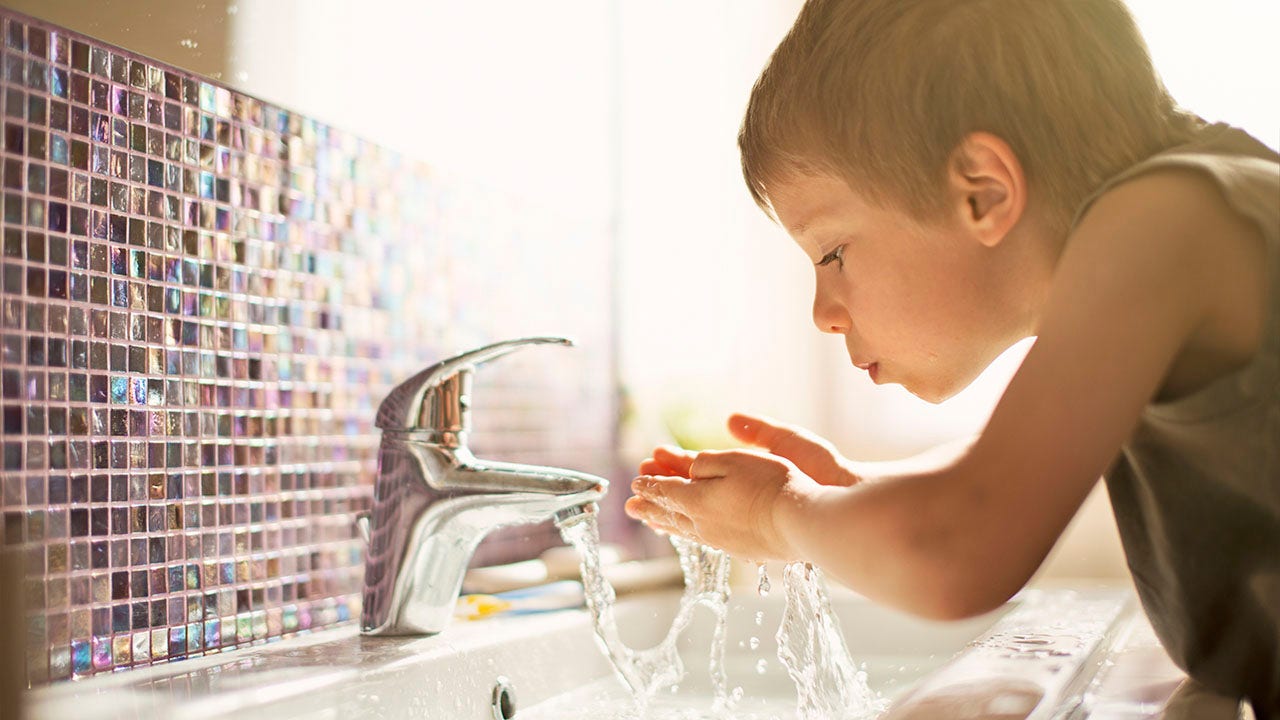Health
Bring Back the Parasol

As I hurried to an appointment one recent afternoon in New York City, the harsh sun seemed to set my skin and hair on fire. Sweat pooled under my sunglasses, and my T-shirt and shorts stuck to my damp skin. I was miserable.
I should have been used to the heat. I grew up in southern India, where the temperature routinely swept past 100 degrees Fahrenheit. But I had abandoned all the tricks and strategies I had used then.
To begin with, I was walking outside at about 3 p.m. In India, I rarely ventured out between 11 a.m. and 4 p.m., or if I did I was fully equipped to face the sun. I usually carried an umbrella, much as women in Victorian England carried parasols, to shield my head and face. And I wore salwar kameez, a tunic and loosefitting bottoms made of thin, gauzy cotton.
It turns out that these methods, employed all over South Asia, are rooted in solid science, even though I didn’t realize it then. As climate change sends temperatures soaring around the world, people who are not used to coping with heat could stand to adopt a few strategies from regions that have faced hot weather for generations.
Covering up
In New York I only ever carry an umbrella when it’s rainy, and rarely wear a hat except at the beach. “But in a situation where you’re out in the direct sun, having something to protect you from that direct sun radiation is important,” said Dr. Jill Tirabassi, a sports medicine expert at the University at Buffalo.
Likewise, wearing little clothing in an attempt to stay cool (or cultivate a tan) exposes you to dangerous solar radiation. A better option is to cover up. “You actually want to have breathable layers that will help transfer your heat out,” Dr. Tirabassi said.
People in hot regions, including African deserts, similarly dress in thin, loosefitting clothes, in light colors that reflect the sun’s rays, let in air and facilitate the evaporation of sweat, rather than trap the heat as darker colors do. Clothes made of thin cotton, linen or bamboo are the most breathable, and synthetic fabrics, like polyester and nylon, the least.
“Having that sweat evaporate is a really important way to cool your body when you’re moving or exercising,” Dr. Tirabassi said.
Getting wet
One habit I picked up after observing the locals during summers in France is to spritz my face with water. It can also cool the skin — as long as it’s not too humid — when the water evaporates.
“It’s kind of replicating what the body does when it sweats,” said Dr. Cecilia Sorensen, an emergency medicine physician and director of the Global Consortium on Climate and Health Education at Columbia University.
“Having that layer of cool water or precipitation on your skin actually speeds up your body’s ability to release heat,” she said.
Cool, damp cloths can accomplish the same goal. In northern India, men often wrap a wet scarf or towel around their neck or their head, said Sanjiv Phansalkar, a rural development expert at the nonprofit VikasAnvesh Foundation.
In Nagpur, Dr. Phansalkar’s hometown, “anybody going out in the street in the summer without their head and ears being covered by a cloth will be immediately stopped by a stranger and made to do so,” he said.
Dr. Sorensen said this practice makes scientific sense: The neck is replete with blood vessels, which widen at high temperatures. The dilated vessels carry more hot blood from the core of the body to the skin, where heat dissipates into the air. In fact, when people turn up in emergency rooms with a heat illness, doctors often pack the neck area with ice and cold towels to rapidly lower their body temperature, she said.
Hydrating with fruit and vegetables
Sweating is the body’s natural cooling mechanism, but the moisture lost must be promptly replaced. That can be accomplished by drinking water, eating watery vegetables and fruit like cucumbers, watermelon and mangoes, or liquids like soups — yes, soups. People in the tropics often eat hot soups, in order to cool off by sweating.
“Everybody knows hydration, hydration, hydration, but what we miss is that hydration doesn’t necessarily mean only drinking water,” said Dr. Asim Shah, a professor of community and family medicine at Baylor College of Medicine in Houston who has studied the impact of heat. He said water should be combined with electrolytes, electrically charged minerals like sodium, calcium and potassium that are needed for nerve and muscle function and maintaining pH levels.
When I was growing up in India, bottled water was not as ubiquitous as it is today. Coconuts, heaped high in roadside stalls, offered an inexpensive, safe and delicious alternative. Vendors would use a small machete to slice open the top of the coconut. When I’d had my fill of the cool, sweet water, I would break the coconut open and eat its moist white meat.
Coconut water is more beneficial than plain water because it has electrolytes. (Most brands of bottled coconut water preserve them, but some also come with unwanted added sugar or artificial flavors.)
Doctors generally warn against drinking alcohol in the heat because it is a diuretic and can lead to dehydration. If you do drink, margaritas make a good option because the salt on the rim can replenish sodium lost to sweat, said Dr. Sorensen, whose family is from Ecuador.
Smarter schedules
The best way to protect yourself from the sun is to avoid it as much as possible. In various cultures, that means scheduling work for the hours when the daylight is less intense.
Many people in southern India, and especially those who toil outside, begin their workday around 4 a.m. and work until no later than noon. The afternoon often includes a nap. Work then resumes at 4 or 5 p.m. for a few more hours.
“There was like a completely different rhythm of life,” recalled Krishna AchutaRao, a climate scientist at the Indian Institute of Technology in Delhi who grew up in the South Indian state of Tamil Nadu. The routine is now less common than it was in his childhood, he said, as Western rhythms and office life have taken over Indian cities.
Some Central and South American countries and some in Europe, Asia and Africa follow a similar schedule, with a nap built into the hottest afternoon hours. As unrelenting heat grips Europe, countries like Germany, which once sneered at the idea, are now considering taking midday breaks too.
Naturally cool homes
Few Indian households have air conditioning; traditional homes manage to stay cool using other techniques.
One key approach is to open windows early in the day and close them before it begins to warm up. Heavy, dark curtains block light and heat from entering the house, and ceiling fans circulate the cool air trapped inside. My family home had curtains made of khus, a native Indian grass, which we sprayed with water every couple of hours. The curtains transformed hot gusts into cool, fragrant breezes.
Many traditional Indian homes have verandas, high ceilings and walls of mud that keep the interior cool. New Orleans, where Dr. AchutaRao lived for nine years, is famous for its shotgun houses — linear buildings in which a bullet shot through the front door can in theory exit through the back door without hitting anything on the way — that allow the air to flow freely. Because heat rises, high ceilings and ceiling fans also keep the living spaces cool.
Not having such simple strategies in place can make even milder temperatures unbearable. Dr. AchutaRao recalled being in Oxford, England, when it was around 90 degrees Fahrenheit, lower than the triple-digit temperatures he was used to. But there was no ceiling fan, and the windows could let light in but wouldn’t open wide enough to allow a breeze.
That temperature “is a routine day in India, but it felt so much worse,” Dr. AchutaRao recalled.
He lamented that some of these older strategies may have become useless — for example, early mornings are frequently so warm now that even waking up at 4 a.m. may not always offer a comfortable start to the day.
Climate change’s rapid pace demands solutions that can keep houses and bodies cool even when the mercury keeps rising, he added.
“You’re no longer adjusting to one hot day or a couple of hot days, you’re looking at weeks upon weeks of having to deal with this,” Dr. AchutaRao said. “This is the cultural shift that people have to make in their heads.”

Health
Children exposed to higher fluoride levels found to have lower IQs, study reveals

The debate about the benefits and risks of fluoride is ongoing, as RFK Jr. — incoming President Trump’s pick for HHS secretary — pushes to remove it from the U.S. water supply.
“Fluoride is an industrial waste associated with arthritis, bone fractures, bone cancer, IQ loss, neurodevelopmental disorders and thyroid disease,” RFK wrote in a post on X in November.
A new study published in JAMA Pediatrics on Jan. 6 found another correlation between fluoride exposure and children’s IQs.
RFK JR. CALLS FOR REMOVAL OF FLUORIDE FROM DRINKING WATER, SPARKING DEBATE
Study co-author Kyla Taylor, PhD, who is based in North Carolina, noted that fluoridated water has been used “for decades” to reduce dental cavities and improve oral health.
Fluoride exposure has been linked to a variety of negative health effects, yet benefits oral health. (iStock)
“However, there is concern that pregnant women and children are getting fluoride from many sources, including drinking water, water-added foods and beverages, teas, toothpaste, floss and mouthwash, and that their total fluoride exposure is too high and may affect fetal, infant and child neurodevelopment,” she told Fox News Digital.
The new research, led by scientists at the National Institute of Environmental Health Sciences (NIEHS), analyzed 74 epidemiological studies on children’s IQ and fluoride exposure.
FEDERAL JUDGE ORDERS EPA FURTHER REGULATE FLUORIDE IN DRINKING WATER DUE TO CONCERNS OVER LOWERED IQ IN KIDS
The studies measured fluoride in drinking water and urine across 10 countries, including Canada, China, Denmark, India, Iran, Mexico, Pakistan, New Zealand, Spain and Taiwan. (None were conducted in the U.S.)
The meta-analysis found a “statistically significant association” between higher fluoride exposure and lower children’s IQ scores, according to Taylor.
“[It showed] that the more fluoride a child is exposed to, the more likely that child’s IQ will be lower than if they were not exposed,” she said.

Scientists found a “statistically significant association” between higher fluoride exposure and lower children’s IQ scores. (iStock)
These results were consistent with six previous meta-analyses, all of which reported the same “statistically significant inverse associations” between fluoride exposure and children’s IQs, Taylor emphasized.
The research found that for every 1mg/L increase in urinary fluoride, there was a 1.63-point decrease in IQ.
‘Safe’ exposure levels
The World Health Organization (WHO) has established 1.5mg/L as the “upper safe limit” of fluoride in drinking water.
“There is concern that pregnant women and children are getting fluoride from many sources.”
Meanwhile, the U.S. Public Health Service recommends a fluoride concentration of 0.7 mg/L in drinking water.
“There was not enough data to determine if 0.7 mg/L of fluoride exposure in drinking water affected children’s IQs,” Taylor noted.
FDA BANS RED FOOD DYE DUE TO POTENTIAL CANCER RISK
Higher levels of the chemical can be found in wells and community water serving nearly three million people in the U.S., the researcher noted.
She encouraged pregnant women and parents of small children to be mindful of their total fluoride intake.

Nearly three million people have access to wells and community water with fluoride levels above the levels suggested by the World Health Organization. (iStock)
“If their water is fluoridated, they may wish to replace tap water with low-fluoride bottled water, like purified water, and limit exposure from other sources, such as dental products or black tea,” she said.
“Parents can use low-fluoride bottled water to mix with powdered infant formula and limit use of fluoridated toothpaste by young children.”
For more Health articles, visit www.foxnews.com/health.
While the research did not intend to address broader public health implications of water fluoridation in the U.S., Taylor suggested that the findings could help inform future research into the impact of fluoride on children’s health.
Dental health expert shares cautions
In response to this study and other previous research, Dr. Ellie Phillips, DDS, an oral health educator based in Austin, Texas, told Fox News Digital that she does not support water fluoridation.

The study researcher encouraged parents of small children to be mindful of their total fluoride intake. (iStock)
“I join those who vehemently oppose public water fluoridation, and I question why our water supplies are still fluoridated in the 21st century,” she wrote in an email.
“There are non-fluoridated cities and countries where the public enjoy high levels of oral health, which in some cases appear better than those that are fluoridated.”
CLICK HERE TO SIGN UP FOR OUR HEALTH NEWSLETTER
Phillips called the fluoride debate “confusing” even among dentists, as the American Dental Association (ADA) advocates for fluoride use for cavity prevention through water fluoridation, toothpaste and mouthwash — “sometimes in high concentrations.”

Fluoride is used in water, toothpaste and mouthwash to help prevent cavities. (iStock)
“[But] biologic (holistic) dentists generally encourage their patients to fear fluoride and avoid its use entirely, even if their teeth are ravaged by tooth decay,” she said.
“Topical fluoride is beneficial, while systemic consumption poses risks.”
Phillips encouraged the public to consider varying fluoride compounds, the effect of different concentrations and the “extreme difference” between applying fluoride topically and ingesting it.
“Topical fluoride is beneficial, while systemic consumption poses risks,” she cautioned.
“Individuals must take charge of their own oral health using natural and informed strategies.”
The study received funding from the National Institute of Environmental Health Sciences (NIEHS), the National Institutes of Health (NIH) and the Intramural Research Program.
Health
Treating Other Diseases With Ozempic? Experts Weigh In | Woman's World

Sign Up
Create a free account to access exclusive content, play games, solve puzzles, test your pop-culture knowledge and receive special offers.
Already have an account? Login
Use left and right arrow keys to navigate between menu items.
Use escape to exit the menu.
Health
FDA bans red food dye due to potential cancer risk

FDA looks to ban red food dye
Celebrity fitness trainer Jillian Michaels joins ‘Hannity’ to discuss the possibility of the FDA banning red food dye.
The U.S. Food and Drug Administration (FDA) has officially banned red dye — called Red 3, or Erythrosine — from foods, dietary supplements and ingested medicines, as reported by the Associated Press on Wednesday.
Food manufacturers must remove the dye from their products by January 2027, while drug manufacturers will have until January 2028 to do so, AP stated.
Any foods imported into the U.S. from other countries will also be subject to the new regulation.
RED FOOD DYE COULD SOON BE BANNED AS FDA REVIEWS PETITION
“The FDA is taking action that will remove the authorization for the use of FD&C Red No. 3 in food and ingested drugs,” said Jim Jones, the FDA’s deputy commissioner for human foods, in a statement.
The U.S. Food and Drug Administration has officially banned red dye — called Red 3, or Erythrosine — from foods, dietary supplements and ingested medicines (iStock)
“Evidence shows cancer in laboratory male rats exposed to high levels of FD&C Red No.3,” he continued. “Importantly, the way that FD&C Red No. 3 causes cancer in male rats does not occur in humans.”
The synthetic dye, which is made from petroleum, is used as a color additive in food and ingested drugs to give them a “bright cherry-red color,” according to an online statement from the FDA.

Food manufacturers must remove the dye from their products by January 2027, while drug manufacturers will have until January 2028 to do so. (iStock)
The petition to ban the dye cited the Delaney Clause, which states that the agency cannot classify a color additive as safe if it has been found to induce cancer in humans or animals.
The dye was removed from cosmetics nearly 35 years ago due to potential cancer risk.
CLICK HERE TO SIGN UP FOR OUR HEALTH NEWSLETTER
“This is a welcome, but long overdue, action from the FDA: removing the unsustainable double standard in which Red 3 was banned from lipstick but permitted in candy,” said Dr. Peter Lurie, director of the group Center for Science in the Public Interest, which led the petition effort, as reported by AP.

Nearly 3,000 foods are shown to contain Red No. 3, according to Food Scores, a database of foods compiled by the Environmental Working Group. (iStock)
Dr. Marc Siegel, clinical professor of medicine at NYU Langone Health and Fox News senior medical analyst, applauded the FDA’s ban.
“It was a long time coming,” he told Fox News Digital. “It’s been more than 30 years since it was banned from cosmetics in the U.S. due to evidence that it is carcinogenic in high doses in lab rats. There needs to be a consistency between what we put on our skin and what we put into our mouths.”
“There needs to be a consistency between what we put on our skin and what we put into our mouths.”
Siegel said he believes the FDA’s decision could be tied to the incoming new head of the Department of Health and Human Services, Robert F. Kennedy Jr.
“They knew it would have happened anyway under RFK Jr.,” he said. “It is already banned or severely restricted in Australia, Japan and the European Union.”

The food additive also “drew kids in” to a diet of empty calories and ultraprocessed foods, one doctor stated. (iStock)
The food additive also “drew kids in” to a diet of empty calories and ultraprocessed foods, Siegel added.
“It has also been linked to behavioral issues in children, including ADHD.”
Nearly 3,000 foods are shown to contain Red No. 3, according to Food Scores, a database of foods compiled by the Environmental Working Group.
For more Health articles, visit www.foxnews.com/health
The National Confectioners Association provided the below statement to Fox News Digital.
“Food safety is the number one priority for U.S. confectionery companies, and we will continue to follow and comply with FDA’s guidance and safety standards.”
The petition to remove Red No. 3 from foods, supplements and medications was presented in 2022 by the Center for Science in the Public Interest and 23 other organizations and scientists.
-
/cdn.vox-cdn.com/uploads/chorus_asset/file/25822586/STK169_ZUCKERBERG_MAGA_STKS491_CVIRGINIA_A.jpg)
/cdn.vox-cdn.com/uploads/chorus_asset/file/25822586/STK169_ZUCKERBERG_MAGA_STKS491_CVIRGINIA_A.jpg) Technology1 week ago
Technology1 week agoMeta is highlighting a splintering global approach to online speech
-

 Science7 days ago
Science7 days agoMetro will offer free rides in L.A. through Sunday due to fires
-
/cdn.vox-cdn.com/uploads/chorus_asset/file/23935558/acastro_STK103__01.jpg)
/cdn.vox-cdn.com/uploads/chorus_asset/file/23935558/acastro_STK103__01.jpg) Technology6 days ago
Technology6 days agoAmazon Prime will shut down its clothing try-on program
-

 News1 week ago
News1 week agoMapping the Damage From the Palisades Fire
-

 News1 week ago
News1 week agoMourners Defy Subfreezing Temperatures to Honor Jimmy Carter at the Capitol
-
/cdn.vox-cdn.com/uploads/chorus_asset/file/25826211/lorealcellbioprint.jpg)
/cdn.vox-cdn.com/uploads/chorus_asset/file/25826211/lorealcellbioprint.jpg) Technology6 days ago
Technology6 days agoL’Oréal’s new skincare gadget told me I should try retinol
-
/cdn.vox-cdn.com/uploads/chorus_asset/file/25832751/2192581677.jpg)
/cdn.vox-cdn.com/uploads/chorus_asset/file/25832751/2192581677.jpg) Technology3 days ago
Technology3 days agoSuper Bowl LIX will stream for free on Tubi
-

 Business4 days ago
Business4 days agoWhy TikTok Users Are Downloading ‘Red Note,’ the Chinese App



/cdn.vox-cdn.com/uploads/chorus_asset/file/25530683/Screenshot_2024_07_14_at_6.17.45_PM.png)










